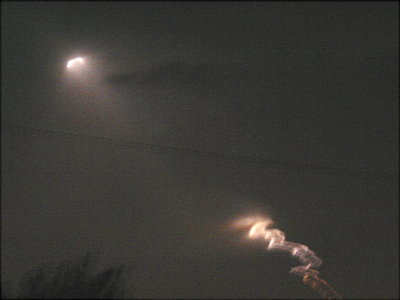"A modified Minuteman intercontinental ballistic missile (ICBM) target vehicle was launched from Vandenberg AFB, Calif., at 10:00 p.m. EDT [7 p.m. PDT], and a prototype interceptor was launched approximately 22 minutes later and 4,800 miles away from the Ronald Reagan Missile Site, Kwajalein Atoll, in the Republic of the Marshall Islands. The intercept took place approximately six minutes after the interceptor was launched, at an altitude in excess of 140 miles above the earth, and during the midcourse phase of the target warhead's flight. This was the fifth successful intercept -- and the fourth consecutive -- in seven flight tests since October 1999 for the GMD program.
This test involved for the first time the participation of a U.S. Navy Aegis destroyer, the USS John Paul Jones, using its SPY-1 radar system to track the flight of the target missile. Although the radar was not integrated into the battle management system for the intercept, it did gather important data on the capabilities of the radar against a long-range ballistic missile.
This system-level test successfully demonstrated "hit to kill" technology to intercept and destroy a long-range ballistic missile target. In addition to the Exoatmospheric Kill Vehicle (EKV) locating, tracking, and intercepting the target resulting in its destruction using only body-to-body impact, this test also demonstrated the successful integrated operation of space and ground-based sensors and radars, as well as the Battle Management, Command Control and Communications (BMC3) function to detect the launch of the target missile, cue an early warning radar to provide more detailed target location data; and integration of a prototype X-Band radar (based at Kwajalein) to provide precise target data to the EKV, which received the target updates from the In-Flight Interceptor Communications Systems (IFICS) at Kwajalein.
The EKV separated from its rocket booster more than 1,400 miles from the target warhead. After separation, it used its on-board infrared and visual sensors, augmented with the X-Band radar data provided by BMC3 via the In-flight Interceptor Communications System, to locate and track the target. Sensors aboard the EKV also successfully selected the mock warhead from among the five objects in the target array, including three decoys. Only system-generated data was used for the intercept after the EKV separated from its booster rocket.
Tonight's test is a major step in an aggressive developmental test program, and will continue the pursuit of a testing regime to achieve a layered approach to missile defense, using different architectures to deter the growing threat of ballistic missiles carrying weapons of mass destruction.
Over the next several weeks, government and industry program officials will conduct an extensive analysis of the data received during the flight test to determine whether anomalies or malfunctions occurred during the test, evaluate system performance and determine whether or not all flight test objectives were met. Since the system is in the developmental phase of design and testing, performance of individual elements and the overall system integration was as important as the actual intercept."





